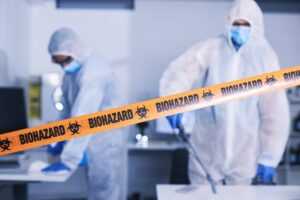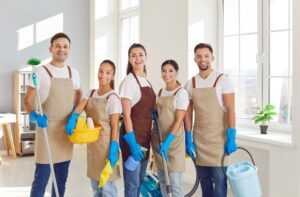Office cleaning has become incredibly important to ensure the safety of employees and customers. As Wisconsin businesses re-open, it’s time for management and employees to step up their office cleaning and become more cognizant of regular cleaning and disinfection. To be clear, cleaning is the process of ridding items and surfaces of dirt and debris. Disinfection removes germs.
There are two types of regular disinfection: 1) a deep sanitation, and 2) surface disinfection. The latter should be done throughout the business day by an assigned employee. Every surface should be disinfected with a product that contains at least 70% alcohol or is a diluted bleach solution.
Tips for Business Cleaning and Sanitation
- Always clean first and follow with a disinfection.
- Assign the task to an employee to ensure it is completed.
- Equip employees with personal protective equipment to ensure there are no adverse effects from regular disinfections.
- If possible, ensure adequate ventilation when disinfecting.
- Follow directions on disinfectants.
- DO NOT mix disinfectants.
- Never mix bleach with ammonia.
- If disinfecting is part of job requirements, train employees to use personal protective equipment and disinfectants.
- Establish a regular schedule of surface disinfections.
- Follow CDC guidelines for disinfection.
- Always wash hands after disinfecting.
- Schedule a regular office cleaning and deep sanitation. (The actual frequency depends on foot traffic. A deep sanitation should also be scheduled when an employee is sick.)
Office Cleaning and Disinfection Surfaces
The following surfaces are frequently used and should be disinfected on a regular basis:
Entry Doors
All entry doors should be disinfected on a regular basis, including doors that slide. The doors should be disinfected in any area that is frequently touched by employees and visitors.
Restroom Faucets
Manual restroom faucets should be completely disinfected. Touch-free models may not need to be cleaned as often. A business restroom should be cleaned regularly and a restroom cleaning checklist should be provided.
Stall Handles
When cleaning and disinfecting restroom stalls, the entire stall door should be wiped down or sprayed.
Toilet Handles
Toilet handles are one of the most frequently used surfaces and should be disinfected on a regular basis.
Trash Cans
All trash cans should be disinfected, including small trash receptacles in restroom stalls. Employees should wear personal protective equipment when removing trash.
Paper Towel Dispensers
Paper towel dispensers handles and any other frequently used surfaces should be disinfected.
Interior Doors
Door knobs and push plates should be completely disinfected.
Registers/Card Processing Stations
All registers and card processing stations should be disinfected. If possible, the stations should be covered to make cleaning easier.
Computers
Computers and tablets should be disinfected with care to ensure there is no damage. If this task needs to be completed by the employee using the item, make disinfectants and training available.
Phones
Phones and headsets are a hotbed for germs and should be disinfected regularly.
Printers
Printers are a commonly used item and should be disinfected, ideally after each user touches the machine.
Cabinet Handles
Any cabinet that is used, including file cabinets, storage cabinets, kitchen cabinets, and other furniture, should be the subject of a regular office cleaning and disinfection. If possible, disinfection should occur after every use.
Light Switches
Even touch-free light switches should be disinfected on a regular basis.
Tables & counters
Conference and display tables are frequently touched and utilized, as well as counters. Every area should be wiped down, including any plexiglass barriers.
Desks
Desk surfaces and handles should be wiped down on a regular basis. For a more in-depth office cleaning and sanitation, contact a commercial cleaning service to schedule a cleaning during non-peak times.


